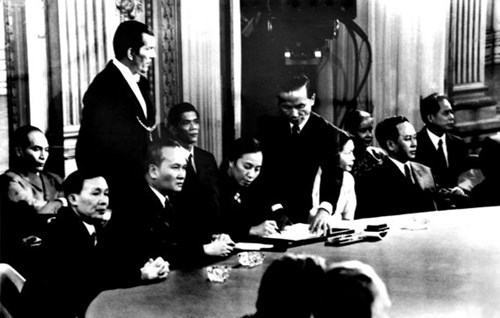On May 13, 1968, the negotiation between the Democratic Republic of Vietnam (DRV) started; and nearly 6 months later, the two sides reached agreement that US should end its military operations in Vietnam from October 31, 1968, and that the two sides would resume a meeting in Paris with the participation of 4 parties, namely the Democratic Republic of Vietnam, National Front for the Liberation of South Vietnam or National Liberation Front (NLF), the US Government and US-backed Saigon Government to discuss issues on ending the war and restoring peace in Vietnam.
On January 25, 1969, the first session of the Paris Talks started, opening the period “Fighting While Negotiating” or “Force and Diplomacy.” The Paris Talks became the longest negotiation process on ending a war in the 20th century. In fact, the war took place in a country but it contained the focal contemporary conflict and contradiction between the movements of national liberation and socialism, and imperialism and international reactionary forces or peace and war. The talks represented two forces in the battlefield: the invading force with preeminent economic, military power but weaknesses in politics and spirit, and the revolutionary national liberation force weak in economic, military power but very powerful in terms of politics, spirit and justice.
    |
 |
|
Nguyen Thi Binh, Minister of Foreign Affairs of the Provisional Revolutionary Government of South Vietnam signed the 1973 Peace Accords |
This was also a struggle between two diplomatic schools: the professional diplomacy of a superpower and the young revolutionary State’s diplomacy. Paris saw a drastic struggle between two strategic minds representing two different kinds of will, justice and ethics.
Both sides sought to impose its own will on the other and wanted the other to accept their conditions and requests. The Vietnamese revolutionary side requested the US to end its invading war, withdraw its military forces from South Vietnam and eliminate its backed government while recognizing and respecting the South Vietnamese people’s self-determination. Meanwhile, the US and its followers’ side also wanted to end the war but requested the DRV to withdraw all Northern forces from South Vietnam, and demanded to maintain demilitarized zones and the US-backed government. With their requests, the US pursued its policy to divide Vietnam timelessly, its aspiration it could not realize in the battlefield.
Meanwhile, each side tried its best to gain decisive military victories in the battlefield in order to make a fundamental change in the power balance in the battlefield so that it could use the military victories as pressures on the other on the negotiating table.
For the Vietnamese revolutionary side, the Paris Peace Talks was not only a normal negotiation but also a front. That front bore great significance in disseminating and encouraging revolutionary forces to fight the enemy for national liberation as well as reconfirming the results of the revolutionary forces in their brave and heroic struggle against the enemy in South Vietnam.
The Vietnamese revolutionary forces’ victories in the 1968 (Mau Than) Tet General Offensive and Uprising and US Linebacker Air Operation in the Hanoi airspace with the use of US B52s in December 1972 undermined the US invaders’ will.
Due to the Mau Than Tet General Offensive and Uprising, US President Johnson acknowledged the US side’s defeat and ordered an end to all air and naval attacks on North Vietnam on March 31, 1968. He also vowed to take the lead in de-escalating the war in Vietnam, and not to run for re-election.
Similarly, suffering big losses in the “Hanoi-Dien Bien Phu in the Air” campaign in December 1972, the Nixon Administration had to declare the end of US bombing in North Vietnam on January 15, 1973. Next, on January 23, 1973, the Paris Peace Accords and related protocols were initialed by Special Envoy of the DRV Le Duc Tho and US Security Advisor Kissinger.
The US military losses in their strategy “Vietnamized war” in South Vietnam and their destructive war in North Vietnam led their final military attempts to bankruptcy, and forced the US side to sign the Agreement on Ending the War and Restoring Peace in Vietnam” on January 27,1973.
The agreement was seen a very important international legal document for the Vietnamese national liberation war under the leadership of the Party, President Ho Chi Minh and directly conducted by the Vietnamese people and army.
The Paris Peace Agreement is also a glorious page of Vietnam’s history, reflecting the great mind and willpower of the Vietnamese people at the time. It serves as a valuable lesson for the next generations of the Vietnamese people.
Written by Deputy-Defense Minister, Senior-Lieutenant General Tran Don
Translated by Thu Nguyen